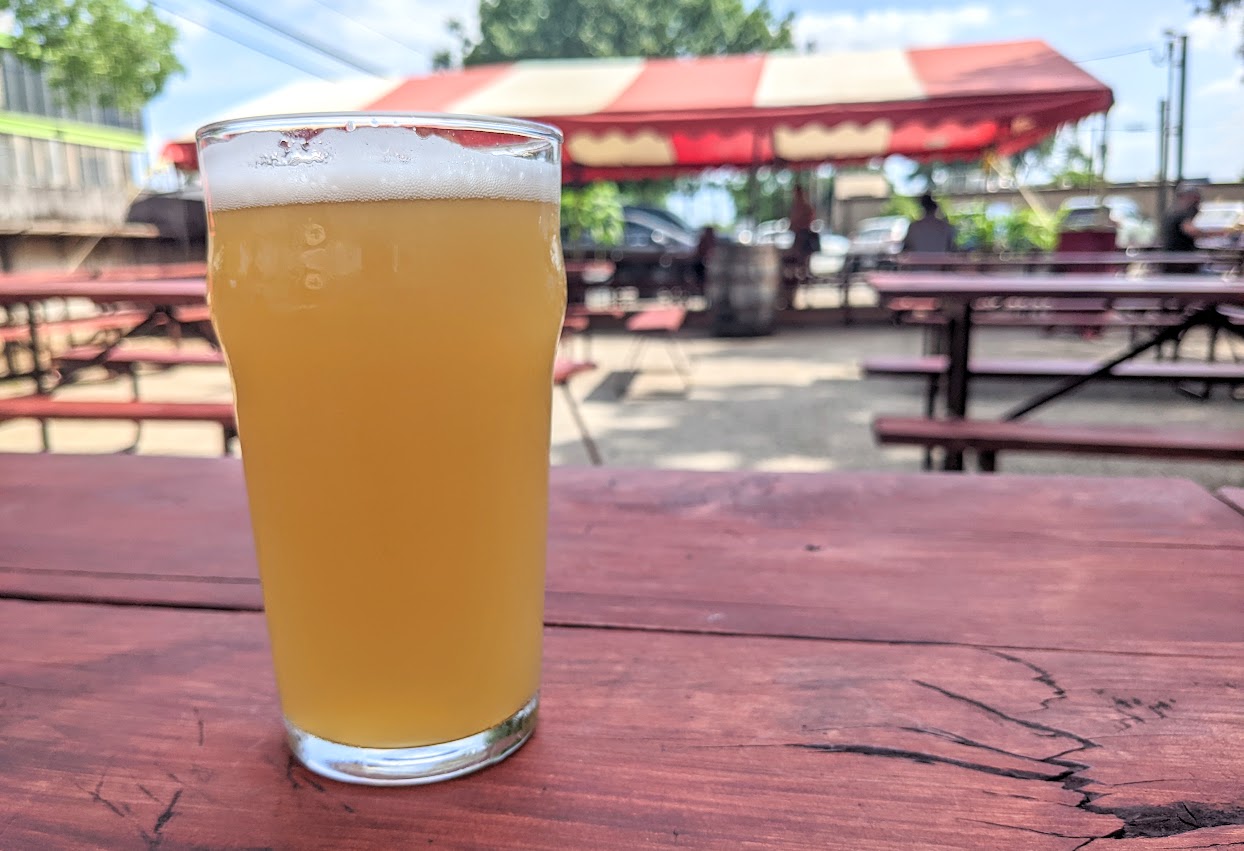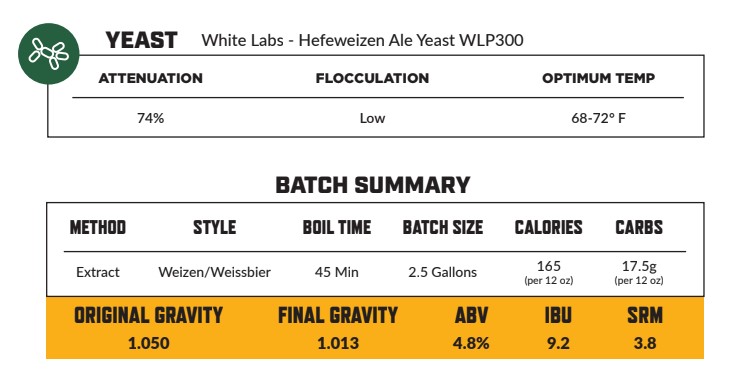Sprung from Bavarian roots centuries ago, Hefeweizen is a beer style that continues to prove a popular pour well into the 21st Century. Once you get your hands on a fresh and bright pint of Hefeweizen, it is easy to see why it remains a signature beer style even in the era of heavily hopped IPAs and bone-dry lagers.
Records show that Hefeweizen has been made in one form or another since at least the early 1500s. That’s quite a run for a beer style, especially one that remains resoundingly popular with contemporary consumers. What has kept this German beer staple so appealing to drinkers over hundreds of years?
Well, simply put, Hefeweizen is a beer style wholly unto its own. There is no beer that easily replaces the appealing aromas, body and appearance of a Hefeweizen, and there are few beer styles that hit the spot on a hot summer day better than a bright and fizzy Hefeweizen.
So, what is Hefeweizen? How is it brewed in its native land, and where can American drinkers pick up some great examples of the style? Continue reading below as we closely examine this traditional beer style, with examples of highly-rated Hefeweizen from around the world. If you want to make your own, you’re in luck as Brewvana shares Hefeweizen recipe secrets from homebrewing pros.
What is Hefeweizen?
Let’s get the most basic principles of Hefeweizen out of the way first, starting with its name. Hefeweizen is a German (and specifically, Bavarian) beer style, and its etymology can be broken down into “hefe”—yeast—and “weizen”—wheat. True to its name, this beer delivers a yeast-forward flavor profile in a wheat beer.
Notably, wheat beers weren’t authorized under the Reinheitsgebot, the Bavarian beer purity law of 1516. That law stipulated that beers in the region could only be made with three basic ingredients—water, hops and barley.
But Weissbier—German wheat beers—were well enjoyed in the 16th Century by a Bavarian royal family, the Dukes of Wittelsbach. This royal family was able to use its influence so that just a single brewery in the village of Schwarzach would be permitted to make Weissbier in Bavaria despite the Reinheitsgebot. Over time, more and more breweries across Bavaria were permitted to make Weissbier.
Hefeweizen is a type of Weissbier, or a beer made with wheat taking up the majority of the grain bill. However, Hefeweizen stands out from other wheat beers because of its unique yeast-driven aromas and flavor notes.
One of the most commonly referenced aromas from Hefeweizen is banana, something that is hard to find in other beers. The yeast traditionally used to brew Hefeweizen drives this distinct aroma, as well as notes of clove, bubblegum and sometimes vanilla. Hefeweizen yeast also often produces a notable spicy phenolic character.
Further, a great Hefeweizen should have a high carbonation, approaching four volumes of CO2. Hefeweizen is also a beer you should be able to taste with your eyes. This is a bright, inviting beer. A tall glass of well-poured Hefeweizen should be incredibly hazy and bright yellow with lively carbonation, as if the bubbles are attempting to jump out of the glass.

Highest Rated Hefeweizen
It should go without saying that many of the best Hefeweizen in the world come from Bavaria. After all, some Bavarian breweries have been making Hefeweizen for hundreds of years and have defined the style.
However, Hefeweizen is a beer that has a peak flavor when it is served fresh. The longer the beer lives in a bottle or can, the more the yeast settles in the bottom of the beer. As a result, there is a decline in both the flavor and overall appearance of the beer.
Unfortunately for American beer drinkers, this means that many of the Hefeweizen bottles that make the journey from across the Atlantic Ocean have already lost some of their peak flavor. In general, it is recommended to drink a bottle of Hefeweizen within 6 months of its packaging date, though bottles up to a year old are certainly still enjoyable. Remember to check the packaging date of imported beers to find the freshest—and tastiest—bottles of Hefeweizen.
For true examples of the style, look out for one of these Bavarian Hefeweizen.
Bayerische Staatsbrauerei Weihenstephan Hefeweissbier
There is perhaps no better place to start your Hefeweizen journey than with the brewery widely considered to be the oldest in the world. Bayerische Staatsbrauerei Weihenstephan claims the brewery site started operations in 1040 (though some dispute that claim) and the brewery has been brewing Weissbier in Bavaria for hundreds of years. This Hefeweizen has a very strong but palatable banana character, making it one of the most recognizable Hefeweizen in the world.
Ayinger Privatbrauerei Bräuweisse
Though not one of the largest breweries in Bavaria, Ayinger Privatbrauerei is still an immensely popular beer maker—and for good reason. Ayinger’s Bräuweisse is perhaps the most full bodied Hefeweizen on the market with what the brewery describes as “champagne-like sparkle”. Honestly, Ayinger isn’t exaggerating here.
Paulaner Brauerei München Hefe-Weissbier Naturtrüb
Yes, Paulaner is known worldwide for its Oktoberfest Bier and its Oktoberfest Märzen, one of the original Oktoberfest beers. But American consumers shouldn’t sleep on Paulaner’s Weissbier. The Paulaner Hefeweizen is a highly rated example of the style, with a highly appealing bright gold, hazy body. Hefe-Weissbier Naturtrüb is yeasty and features the signature Hefeweizen banana flavor, but Paulaner states keen drinkers can also pick up on tropical citrus notes in its beer.
Now that we have classical examples of Old World Hefeweizen out of the way, let’s turn our attention to some homegrown Hefeweizen. There are plenty of examples of world-class Hefeweizen produced in all corners of the United States, and here are a few notable examples.
Live Oak Brewing Co. Hefeweizen
Though it hasn’t been around for hundreds of years like some German breweries, Live Oak Brewing Co. has been making sought-after European-style beers in Austin for decades now. Made with traditional brewing techniques, Live Oak Hefeweizen is perhaps the brewery’s most famous beer. This beer is incredibly inviting with a bright goldenrod flavor, a silky body and pleasant banana and pepper aromas with the slightest hint of vanilla. Live Oak Hefeweizen is one of the best examples of the style in America today.
KC Bier Co. Hefeweizen
Like Live Oak, KC Bier Co. is dedicated to the craft of recreating European-style ales and lagers here in the U.S. The Kansas City-based brewery is obsessed with German beers and imports yeast, hops and malt from the country. The result? Astonishingly clean beers like its Hefeweizen. Look for spicy phenolic notes on top of fruity esters and a strong, bready yeast profile from this beer.
Penn Brewery Penn Weizen
Pittsburgh’s Penn Brewery has been brewing its Hefeweizen for more than 30 years now, and each bottle is as good as the last. This beer was made to enjoy in warmer weather and has a higher perception of citrus notes than found in other Hefeweizen. Still lightly hopped, well carbonated and bright gold, Penn Weizen is a Hefeweizen worth looking out for.
Hefeweizen Recipe
If you’re interested in brewing a Hefeweizen for the first time, there are some rules we first need to outline.
This is a beer style that contains hallmark signatures gained from specific ingredients, so there isn’t a lot of fiddling around to do with the recipe itself. By definition, Weissbier (and therefore, all Hefeweizen) needs to have wheat take up at least half of the total grain bill. With that much wheat in the mash, it is easy for the mash to get “stuck”, so including adjuncts such as rice hulls can help you throughout the brewing process. Pale malts are necessary to round out the rest of the grain for brewing Hefeweizen, and German Pilsner malt is recommended here.
Just because the grain bill is pretty much set in stone with this beer doesn’t mean there is no room for experimentation in the mash, though. Brewing processes such as step mashing and even traditional concoction methods will add complexity to the body of your beer. If you have the time, patience and focus to try these brewing methods at home, experiment with them during your Hefeweizen brew day!
The hop selection for Hefeweizen is also fairly easy, though important. Hops should be barely noticed in a true Hefeweizen, if they can be picked up at all.
According to BJCP guidelines, a Hefeweizen should only clock in around 8-15 IBUs, meaning hops should be added in very small quantities during the bittering and aroma stages of the boil. Dry hopping is not recommended here.
Because of this beer’s German roots, hop selection should be limited to Noble hops—Hallertau Mittelfrüh, Saaz, Spalt or Tettnang.
So if the grain bill and hop selection in Hefeweizen are straight forward, where does this iconic beer get its signature characteristics? Well, for your Hefeweizen to shine, it all depends on the yeast.
Let’s get this out of the way right now—if you are making Hefeweizen at home then you should absolutely use a Hefeweizen yeast for your beer. Some professional brewers may use nontraditional yeasts in their brewing process, but Hefeweizen yeast will yield the best results for homebrewers. After all, these yeast strains have been developed over hundreds of years to brew this specific style of beer.
In order to get Hefeweizen yeast to produce the beer’s signature fruity esters and some pronounced phenolic notes, it is imperative to stress this yeast during fermentation. The yeast will have a hard enough time eating through a wheat-heavy wort, but you also want to keep the fermentation temperature around 75°F—much higher than most German-style beers.
All of this stress will make the Hefeweizen yeast work hard during fermentation. This extra work will produce the banana and clove esters found in traditional Hefeweizen. If you’re not a fan of the banana flavor in your beer, just ferment at a lower temperature. Fermenting at around 65-68°F will produce spicy phenols that have notes of cracked pepper.

When it comes time to package, there are a couple of important elements to consider. First, there is no need to clarify your beer with finings or through cold crashing. Hefeweizen is the original hazy beer! Part of the appeal of a good Hefeweizen is the beer’s cloudy appearance. A Hefeweizen’s haze comes partially from yeast in suspension, so don’t filter this beer and remember to drink it fresh.
Also, remember that Hefeweizen are highly carbonated beers. Your Hefeweizen should clock in around four volumes of CO2, similar to the carbonation of Belgian beers. If you are bottling, calculate how much sugar you will need to add before bottle conditioning. Specialty bottles that withstand higher levels of carbonation may be necessary here.